Quality of Mobile Networks in Costa Rica 2023: Coverage, Speed, and User Experience (II)

This article is part of a monographic series examining the state of telecommunications in Costa Rica. In this installment, we focus on mobile networks, essential for ensuring connectivity on the go and meeting the growing demands of users. We assess the quality, coverage, and performance of these networks across various regions of the country. For a more comprehensive perspective, we invite you to read the complementary article, “Fixed network quality in Costa Rica 2023: Coverage, Speed and User Experience (I)”, where we delve into the performance of fixed Internet networks.
This analysis of mobile network quality in Costa Ricade, based on 2023 data, evaluates the performance of the country’s three main operators in their voice and mobile data services. These operators are:
- Claro CR Telecomunicaciones S.A. (Claro)
- Instituto Costarricense de Electricidad (Kölbi)
- Liberty Telecomunicaciones de Costa Rica LY S.A. (Liberty)
Measurements conducted on real commercial services provide an accurate and objective view of how mobile networks perform in everyday situations. This not only allows users to make informed decisions but also promotes competition among operators to continuously improve service quality.
MedUX, through its solutions for regulators, has played a key role in this analysis by providing state-of-the-art measurement tools to monitor network performance in real time. These solutions ensure objective evaluations aligned with user experiences and empower regulators with reliable data to foster continuous improvement in mobile services. The quality and transparency provided by these tools are essential for developing a robust telecommunications ecosystem in Costa Rica.
Methodology for National Mobile Internet Service Evaluation in Costa Rica
Costa Rica's SUTEL (Superintendence of Telecommunications) has implemented a robust measurement system to evaluate the quality of mobile services in 2023. This system uses measurement probes installed in vehicles traveling across the national territory, ensuring diverse area coverage and representative data collection.
The probes are configured to simultaneously measure the performance of the country’s three main operators—Claro, Kölbi, and Liberty—enabling direct and reliable comparisons. This approach complies with the methodology established in resolution RCS-019-2018, related to mobile telephony services, ensuring that evaluations reflect real usage conditions.
The system also includes robust servers that act as counterparts to the mobile probes, facilitating the collection, storage, and processing of large data volumes. This technical approach follows the guidelines established by the International Telecommunication Union (ITU) in recommendation ITU-T E.806 (06/2019), which supports measurement campaigns and monitoring systems as appropriate tools to evaluate mobile network service quality.
MedUX has been a key partner in this initiative, providing advanced technology that ensures real-time measurements and precise data. The measurement methodology not only evaluates the technical performance of the networks but also captures the actual end-user experience in real-world environments and situations.
For more information on measurement methodologies and MedUX solutions that optimize mobile service quality experiences, visit our specialized blog.
Key findings from 2023 report
The 2023 report evaluates the state and performance of mobile networks in Costa Rica through key indicators that determine coverage, voice service quality, and data service quality. The main indicators measured include:
- Mobile Coverage (coverage accuracy and signal strength).
- Unsuccessful Call Percentage (accessibility).
- Dropped Call Percentage (retainability).
- Voice Quality in Telephony Services (Mean Opinion Score, MOS).
- Call Setup Time (waiting time).
- Data Transfer Speed Ratio (measured speed vs. provisioned speed).
- Latency or Delay (network response time).
This year's report was built based on millions of tests conducted by the Costa Rican regulator through "drive test" campaigns. These tests gathered quality conditions offered by the 2G, 3G, and 4G networks of the three main mobile and internet operators: Claro, Kölbi, and Liberty. Measurements were distributed at the provincial level, considering both geographical variations and trends in quality parameters since 2021.
Additionally, factors such as increased network traffic load and the effects of COVID-19 on network behavior were taken into account, as these have impacted performance and indicators. Below are the most relevant results and the evolution of some of these indicators, compared across the three mobile network operators.
Mobile Service Coverage
This indicator verifies the signal strength obtained, comparing it to that indicated by the operators for each type of coverage they report and offer on their websites.
In the following graph, the results obtained for 3G technology can be observed. All operators meet the regulatory threshold of 90% in the 2023 period.
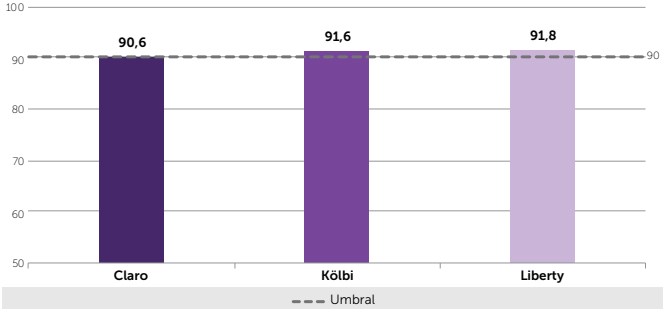
However, for 4G technology, the only operator that meets the threshold is Liberty, while Claro and Kölbi fail to reach it.
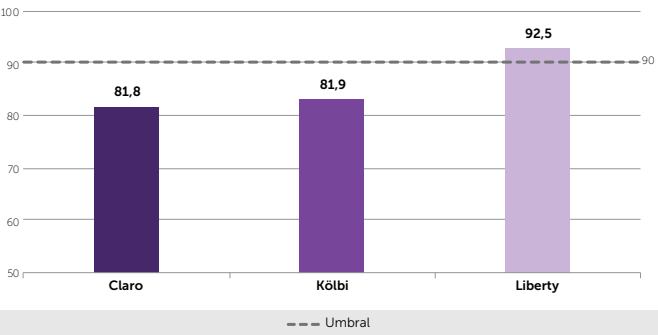
Below is the percentage of coverage area by province for the 4G network of each operator for 2023. It is important to note that in each of the maps, the darkest color indicates better performance.
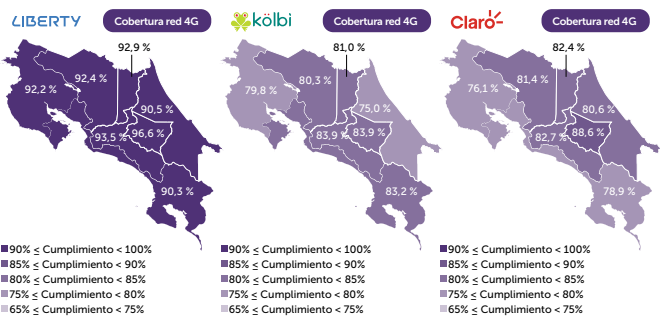
Fuente: SUTEL, Dirección General de Calidad
Percentage of Unsuccessful Calls
This indicator measures the accessibility of mobile telephony services, calculating the proportion of failed calls in relation to the total number of valid call attempts.
The following graph shows the results of the indicator for 2G and 3G technologies. It can be concluded that, on a national average, Claro and Liberty operators maintain a percentage of unsuccessful calls below the regulatory threshold of 3% in 2G technology during 2023, while the Kölbi operator does not meet this standard. Regarding 3G technology, all three operators meet the established limit. It is important to note that the lower the percentage of unsuccessful calls, the better the service performance.
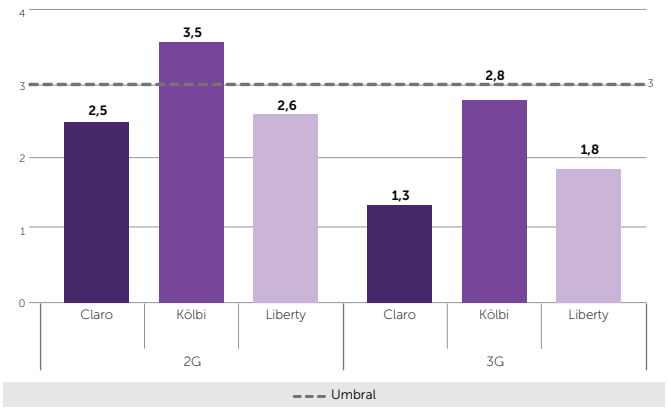
Percentage of Interrupted Calls
This indicator measures the ability to maintain a call without interruptions, counting those that drop before completion due to issues on the operator's network. The allowed threshold is 2% or fewer interrupted calls.
The graph shows the results of this indicator for 2G and 3G technologies. In 2023, all three operators failed to meet the 2G threshold, while in 3G, only Kölbi did not meet the standard, with Claro and Liberty remaining below the threshold. The best results correspond to lower percentages of interruptions.
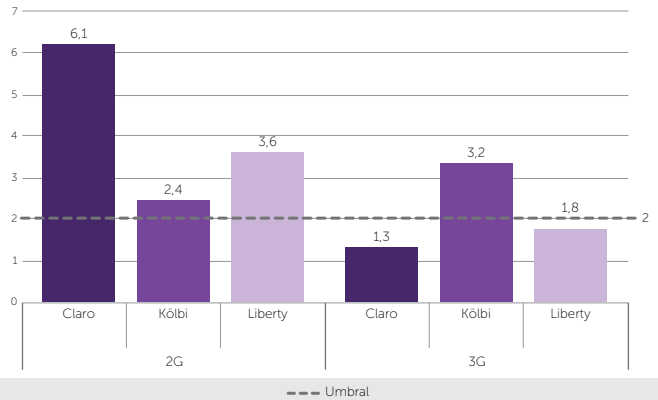
Fuente: SUTEL, Dirección General de Calidad.
Voice Quality in Telephone Services (Mean Opinion Score, MOS)
The "Voice Quality in Telephone Services" indicator measures the fidelity between the audio signals transmitted and received during a call, evaluating the perceived clarity and quality. To calculate this, tests are performed using a standard high-quality voice file through a specialized voice server, applying the POLQA algorithm as per the ITU-T P.863 recommendation. The results are expressed on the MOS (Mean Opinion Score) scale, which ranges from 1 (poor quality) to 5 (excellent). In 2023, only the Liberty operator met the regulatory threshold of 3.5 in 2G and 3G technologies, while Claro and Kölbi did not reach this standard.
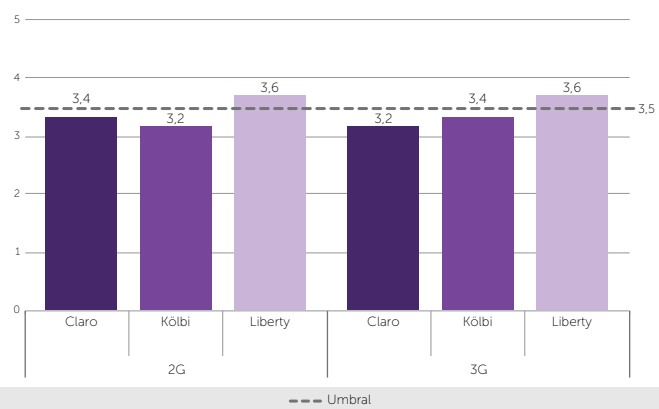
National Average Download Speed
The following graph presents the results of average download speed measurements for 3G and 4G technologies. It is observed that, nationally, all three operators meet the regulatory threshold of 60% in 3G. In contrast, in 4G, none of the operators reach the 70% threshold. It is important to note that results are better the higher the percentage obtained.
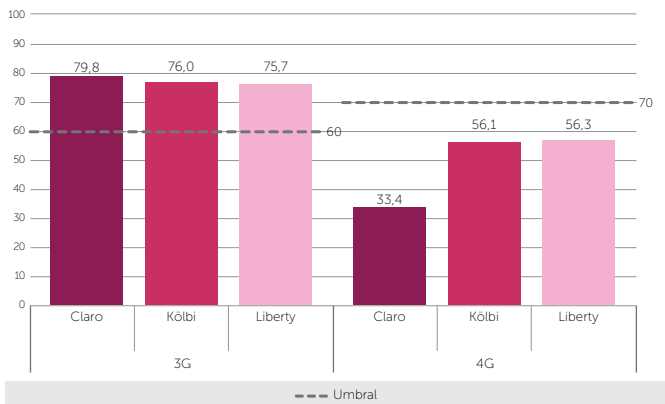
Fuente: SUTEL, Dirección General de Calidad
Below is the evolution of the national average download speed in Mbps for 4G technology during the periods from 2021 to 2023.
It can be seen that between 2021 and 2022 there was a general decrease in the average download speed on the 4G network of the three operators. However, in 2023, all operators improved compared to the previous year. Liberty was the one that grew the most, with an increase of 12.1 Mbps. Kölbi followed with an increase of 3.2 Mbps, although it did not reach the levels of 2021. Claro also increased its speed by 3.2 Mbps but did not surpass its performance in 2021.
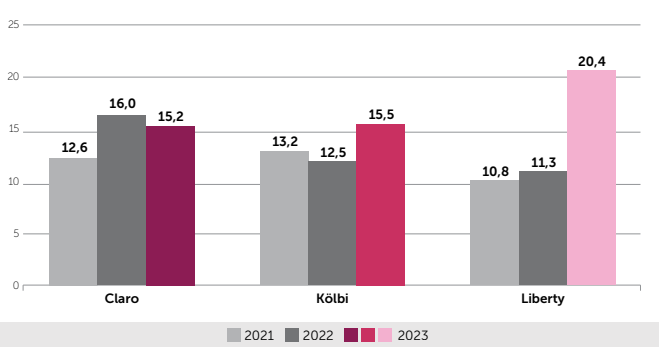
The details of the average download speed by province can also be seen below for the 4G network.
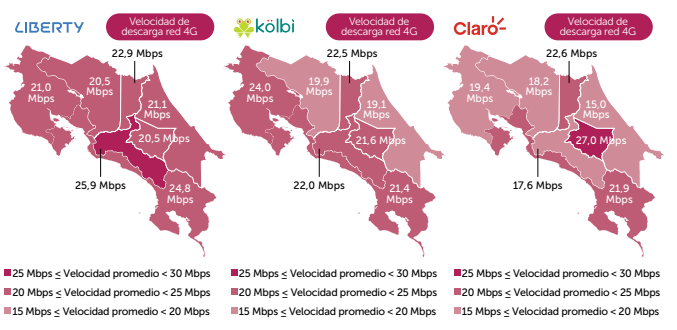
Fuente: SUTEL, Dirección General de Calidad.
Upload Speed
The graph shows the results of average upload speed measurements for 3G and 4G technologies. In 3G, all operators exceed the regulatory threshold of 60%, while in 4G, none reach the 70% threshold. It is important to highlight that results are better the higher the percentage value.
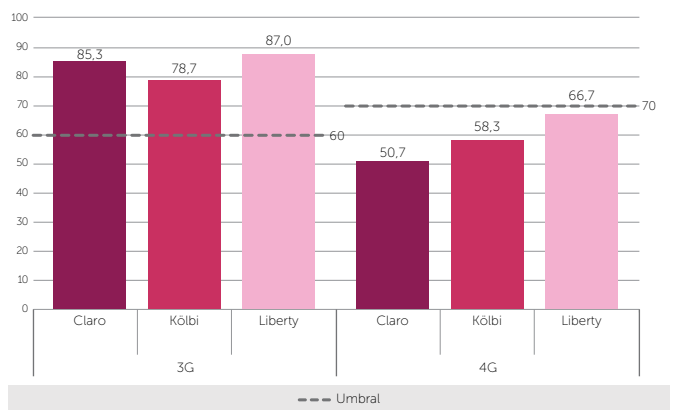
Fuente: SUTEL, Dirección General de Calidad.
The evolution of upload speed in Mbps for 4G technology for the three operators between 2021-2023 is shown below. Between 2022 and 2023, the Claro operator experienced a decrease in the average upload speed on the 4G network. In contrast, Kölbi and Liberty operators achieved improvements in their performance, with increases of 3 Mbps and 9.1 Mbps, respectively, compared to the previous year. It is important to highlight that Liberty was the operator with the greatest increase in average upload speed during the 2023 period.
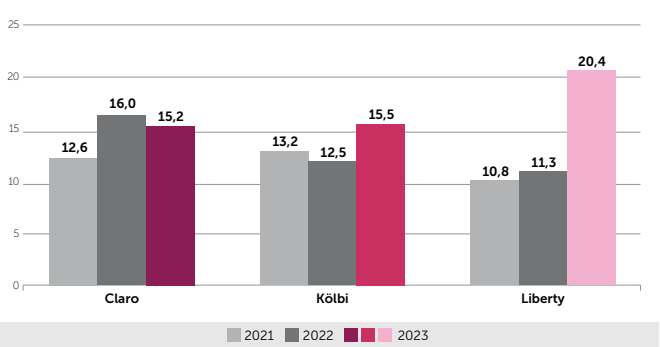
Fuente: SUTEL, Dirección General de Calidad.
Below is the average upload speed in Mbps by province for 4G technology in 2023. In the maps, the darkest tone indicates a higher speed range.
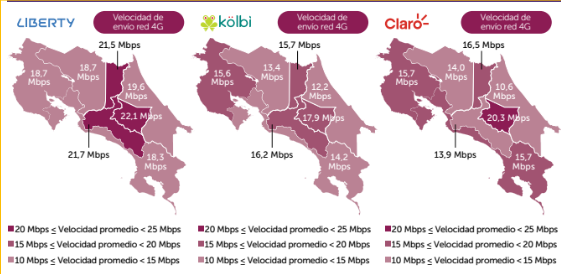
Fuente: SUTEL, Dirección General de Calidad.
Transition of the 2G Network Shutdown
As part of modernizing their infrastructures and complying with regulations, mobile operators Kölbi and Liberty have announced the progressive shutdown of their 2G (GSM) network, a step towards optimizing their networks and improving service quality. These operators have communicated the details of the process to their users, which will be carried out within the following timelines:
- Kölbi: The 2G network shutdown will begin on August 23, 2024, and extend until December 31, 2024.
- Liberty: The shutdown will take place from October 18, 2023, to April 18, 2024.
On the other hand, Claro has stated that it currently has no plans to disconnect its 2G network, although it has committed to adhering to regulations if it decides to proceed with the shutdown in the future.
It is important to note that due to these shutdown plans, the results of 2G network measurements from Kölbi and Liberty will not be used to evaluate service quality nor be subject to the Quality Adjustment Factor (FAC). Conversely, Claro's results will be evaluated according to current regulations.
This change may mainly affect users with older devices or in areas still dependent on this technology. However, it represents progress towards faster and more efficient networks, such as 3G and 4G, which provide higher speeds and better service quality.
Did the quality parameters for mobile Internet services in Costa Rica meet the standards in 2021?
According to Article 49 of the Regulation on the Regime for Final User Protection (RPCS), SUTEL evaluates the results of service quality studies to ensure that operators comply with the established thresholds. When results fall below these thresholds, operators must submit an Improvement Plan to address the deficiencies.
Below are tables showing the indicators not met by each operator and technology during 2023, displaying the national values that failed to meet the established requirements:
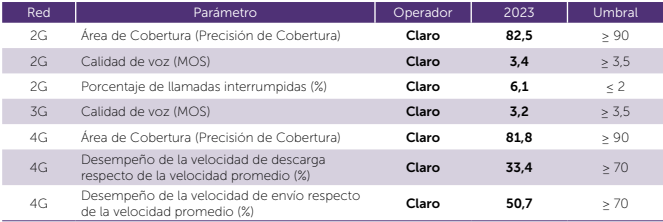
Fuente: SUTEL
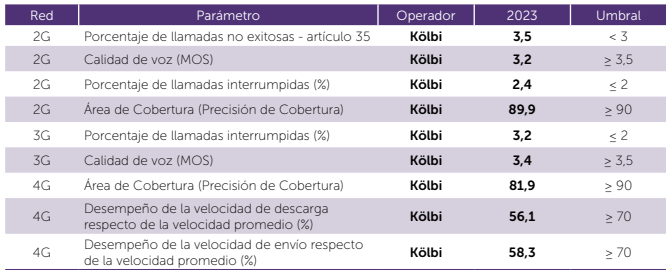
Fuente: SUTEL

Fuente: SUTEL
According to Article 49 of the RPCS, operators with deficiencies must submit an Improvement Plan within a maximum of four quarters. It is essential that this Improvement Plan prioritizes the quality indicators that fell below the established thresholds in 2023.
Quality evaluation tools for end-users
To strengthen transparency and give users more control over the quality of their telecommunications services, SUTEL has implemented several tools that allow Costa Ricans to understand and evaluate the performance of these services across the country.
SUTEL Quality Map
This interactive platform enables users to check the coverage and quality of Internet and mobile network services in various areas of Costa Rica. With this tool, users can visually explore service performance in specific regions, providing clarity on the options available.
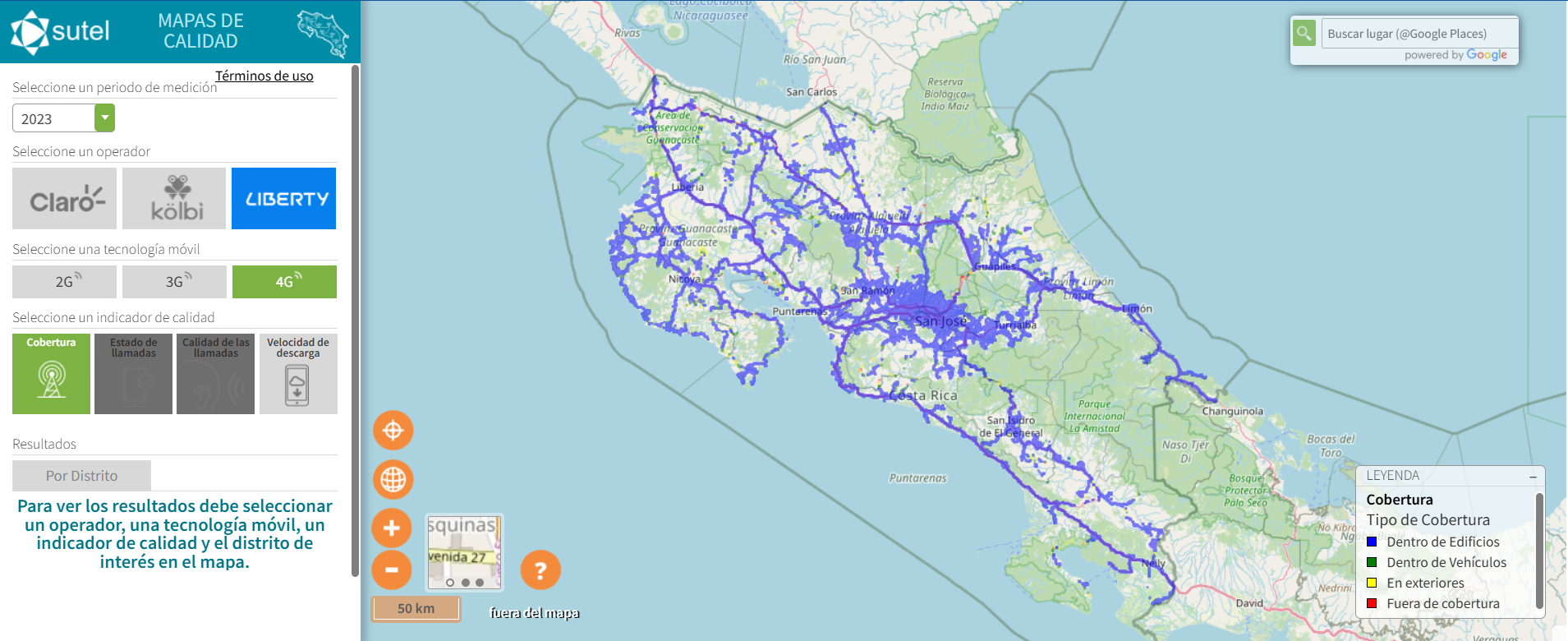
SUTEL Quality Viewer
The Quality Viewer is another tool that provides detailed data on fixed Internet service in different regions. It allows users to evaluate network performance in their localities and compare between various providers, helping them make informed decisions about their service.
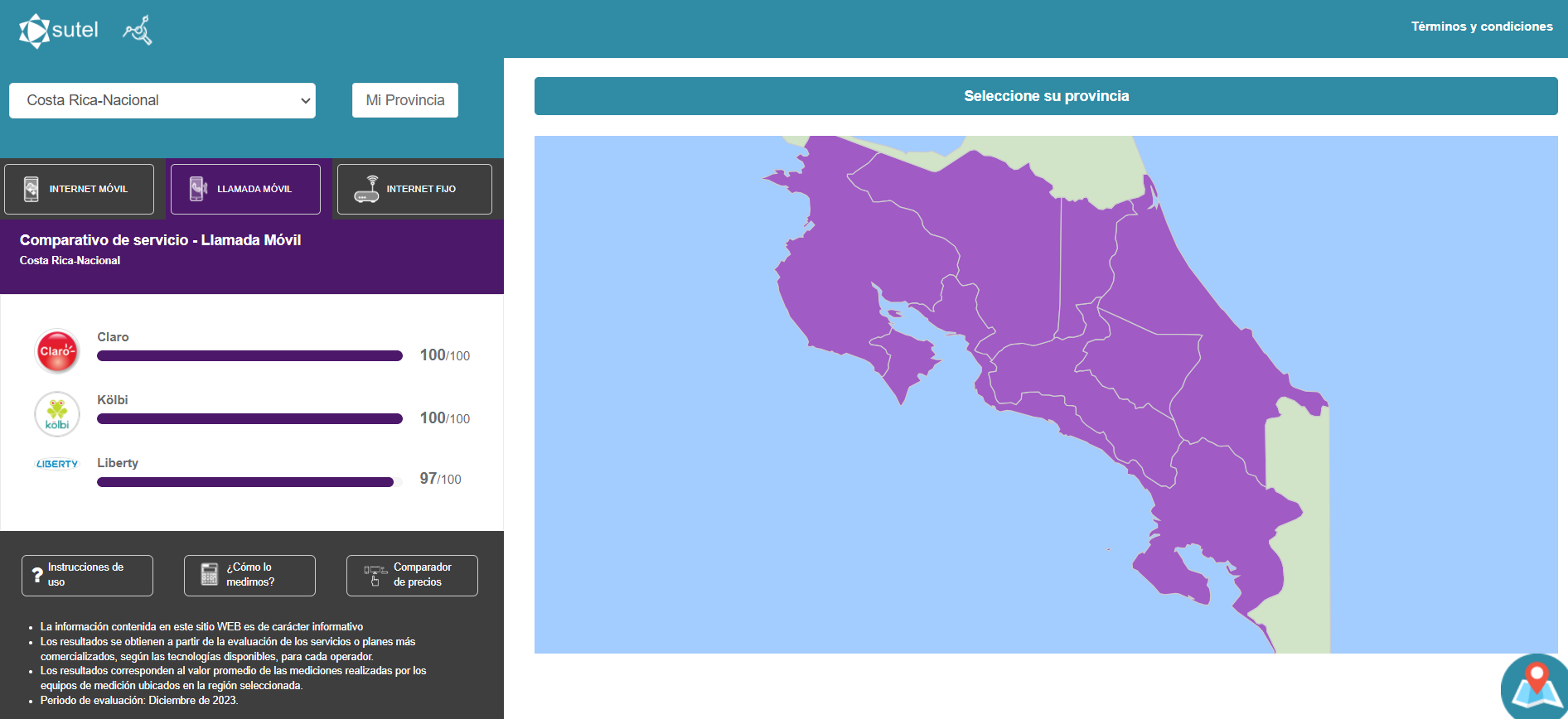
Reports on fixed and mobile networks
SUTEL also makes periodic reports available to users on the quality of fixed and mobile Internet services in Costa Rica. These reports contain detailed analyses of network performance, allowing users to stay informed about both the general and specific quality of services nationwide.
Through these tools, SUTEL aims to ensure that users have access to the information needed to understand and improve the quality of their telecommunications experience in Costa Rica.
Conclusion
In 2023, telecommunications operators in Costa Rica faced various challenges in meeting the quality thresholds established for mobile Internet services. Despite some improvements in key indicators, such as download and upload speeds, several operators failed to meet the required standards in fundamental aspects, necessitating the implementation of Improvement Plans to address the observed deficiencies.
Subscribe to our newsletter to receive our blog articles and much more!
Don’t forget to follow us on social media and subscribe to our newsletter to receive the latest updates and news.
Follow us on:
About MedUX
MedUX is the leading Quality of Experience (QoE) company, providing comprehensive and innovative solutions for measuring the performance of fixed, mobile, and TV telecommunications networks for telecom operators, governments, and digital enterprises. With a focus on delivering grand scale, end-to-end network, and service visibility, MedUX leverages real-time customer perspective data and advanced analytics to ensure quality and regulatory compliance, while also offering valuable insights for optimizing networks and improving customer experiences. With a presence in over 25 countries across Europe, America, Africa, and the Middle East, and monitoring over 60 operators worldwide, MedUX’s patented technology and expertise make it a trusted partner for improving the digital experiences of customers everywhere.
Explore the Latest from MedUX

Chile makes its network speeds visible: SUBTEL’s Regional Fixed Broadband Ranking (October 2025)
SUBTEL has released its October 2025 regional fixed-internet speed ranking, built from 767,924 measurements collected by probes from the Independent Technical Body (OTI). At MedUX, together with Microsystem, we’re the technical engine behind the OTI: we operate the measurement infrastructure and…

Chile Revolutionizes Internet QoS Measurement with a Multiplatform System
Ensuring Transparency and Reliable Connectivity with a QoS Measurement System in Chile In a digitized world, the quality of Internet service (QoS) is key to ensuring a stable and fast connection. Chile, recognized for its leadership in the telecommunications sector in Latin America, has taken a…

Quality of Fixed Networks in Costa Rica 2023: Coverage, Speed, and User Experience (I)
This article is part of a monographic series analyzing the quality of telecommunications networks in Costa Rica. This time, we explore the performance of fixed Internet networks, which are crucial for the country's digital development and the daily lives of Costa Ricans. Through this analysis,…


